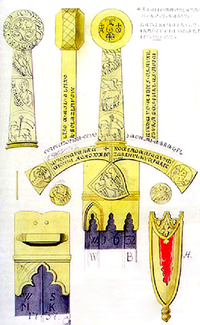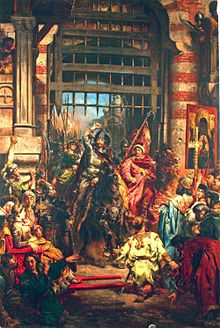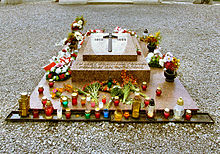- Szczerbiec
-
Szczerbiec
Graphical documentation of the Szczerbiec made by Krzysztof Werner, King Stanislaus Augustus's court painter, in 1764Type Ceremonial sword Place of origin Poland or Germany (possibly Rhineland)[1] Service history In service 13th century as a sword of justice,
1320–1764 as a coronation swordUsed by Poland[2] Production history Produced Late 12th or 13th century[3] Specifications Length 98 cm[2] Blade type Straight double-edged, Oakeshott type XII[4] Hilt type Flat with arched cross-guard, Oakeshott pommel type I[4] Szczerbiec (Polish pronunciation: [ˈʂt͡ʂɛr.bʲɛt͡s]) is the coronation sword that was used in crowning ceremonies of most kings of Poland from 1320 to 1764. It is currently on display in the treasure vault of the Royal Wawel Castle in Kraków as the only preserved piece of Polish Crown Jewels. The sword is characterized by a hilt decorated with kabbalistic formulas, Christian symbols and floral patterns, as well as a narrow slit in the blade which holds a small shield with the coat of arms of Poland. Its name, derived from the Polish word szczerba meaning a gap, notch or chip, is sometimes rendered into English as "the Notched Sword" or "the Jagged Sword", although its blade has straight and smooth edges.
A legend links the Szczerbiec with King Boleslaus the Brave who was said to have chipped the sword by hitting it against the Golden Gate of Kiev (now in Ukraine) during his capture of the city in 1018. However, the Golden Gate was only constructed in 1037 and the sword is actually dated to the late 12th or 13th century. It was first used as a coronation sword by Vladislaus the Elbow-High in 1320. Looted by Prussian troops in 1795, it changed hands several times during the 19th century until it was purchased in 1884 for the Hermitage Museum in Saint Petersburg, Russia. The Soviet Union returned it to Poland in 1928. During World War II, the Szczerbiec was evacuated to Canada and did not return to Kraków until 1959. In the 20th century, an image of the sword was adopted as a symbol by Polish nationalist and far-right movements.
Contents
Description
For the sword-related terminology used in this section, see Sword #Terminology.The Szczerbiec is a 98 cm (3.22 ft) long ceremonial sword bearing rich Gothic ornamentation, dated to the late 12th or 13th century.[5] It is classified as a type XII sword with a type I pommel according to the Oakeshott typology, although the blade may have changed its shape due to centuries of corrosion and intensive cleaning before every coronation.[4]
Hilt
The hilt consists of a round pommel, a flat grip and an arched cross-guard. The grip is rectangular in cross-section and its hard edges make it difficult to handle and impractical for fighting, which is indicative of the sword's purely ceremonial usage. All parts of the hilt are covered with golden plates which are engraved and decorated with niello, or black metallic inlay that contrasts against the golden background. The niello designs include kabbalistic formulas written in late Romanesque majuscule, Christian symbols and floral patterns.[2]
On the obverse side of the hilt, the pommel is decorated with a floral motif. The grip bears the symbols of two of the Four Evangelists: the eagle of Saint John and the angel of Saint Matthew, as well as an Agnus Dei (Lamb of God).[2] The cross-guard bears, above a floral pattern, an inscription in corrupted Hebrew in Latin script: Con citomon Eeve Sedalai Ebrehel ("Fervent faith incite the names of God: Sedalai and Ebrehel").[6] On the opposite ends of the cross-guard, there are again the symbols of Saints John and Matthew.[2]
On the reverse side of the pommel, there is a large stylized letter T between the Greek letters Α and ω (alpha and omega) surmounted with little crosses.[2] Below the letter T, there is another cross placed within a cloud or flower with twelve petals.[7] Around this design runs a circular Latin inscription in two rings which reads: Haec figura valet ad amorem regum / et principum iras iudicum ("This sign rouses the love of kings and princes, the wrath of judges").[6] The reverse side of the grip is decorated with the lion of Saint Mark, the ox of Saint Luke and another Agnus Dei.[2] The cross-guard bears the following Latin inscription: Quicumque hec / nomina Dei secum tu/lerit nullum periculum / ei omnino nocebit ("Whoever will carry these names of God with him, no danger will harm him").[6]
The currently reverse side of the grip and the pommel was most probably originally on the obverse, so that the symbolically more important side of the pommel was visible while the sword was worn by the monarch. At an unknown point in history, this part of the hilt must have been reversed. As a result, both sides of the hilt now display a duplicated pair of Evangelists rather than all four of them.[8] The narrow sides of the grip used to be embellished with inscribed silver plates, which, however, were lost in the 19th century. These lost inscriptions are partly known from graphical documentation of Polish crown jewels made by King Stanislaus Augustus's court painter, Krzysztof Werner, in 1764. One of the plates had already been broken by that time with only part of the inscription preserved: Iste est gladius... Bolezlai Duc... ("This is a sword of... Duke Boleslaus...");[2] the inscription on the other plate continued: Cum quo ei Dominus SOS [Salvator Omnipotens Salvator] auxilietur adversus partes amen[9] ("With whom is the Omnipotent Lord and Savior, to help him against his enemies. Amen"). The missing part of the first inscription is only known from an old replica of the Szczerbiec which once belonged to the Radziwiłł family (see Historical replicas below). The full inscription read: Iste est gladius Principis et haeredis Boleslai Ducis Poloniae et Masoviae, Lanciciae ("This is a sword of Hereditary Prince Boleslaus, Duke of Poland, Masovia, and Łęczyca"). The identity of this Duke Boleslaus is uncertain.[4]
Blade
Just below the hilt, there is a long rectangular slit made in the fuller of the blade. This opening, known in Polish as szczyrba or szczerba, was originally caused by rust and, in the 19th century, polished into a regular shape. A small triangular enameled heraldic shield is fastened to the slit. The shield, bearing the White Eagle of Poland, was originally attached to the scabbard, or sheath. The Gothic scabbard, with a golden or silver locket and chape, was probably created in 1320 and lost between 1819 and 1874. The shield is the only preserved element of the sheath. It was tilted to the left – from the onlooker's point of view – while it was fastened to the scabbard's locket, but today it is aligned with the blade.[10] The eagle on the red field of the shield is white, with a golden crown, bands across the wings, ring on the tail, and talons.
History
The Szczerbiec of Boleslaus the Brave
Historical accounts related to the early history of the Polish coronation sword are scant and often mixed with legend. The earliest known use of the name "Szczerbiec" appeared in the Chronicle of Greater Poland at the turn of the 14th century. According to this source, the sword was given to King Boleslaus the Brave (reigned 992–1025) by an angel; Polish kings were supposed to always carry it in battle to triumph over their enemies. During Boleslaus's invasion of Kievan Rus', he hit it against the Golden Gate of Kiev while capturing the city. It was the notch the appeared on the edge of the blade which gave the sword its name. This account, written three centuries after the events it describes, is implausible not only because of the customary reference to the sword's supernatural origin (compare Excalibur), but also because Boleslaus's intervention in the Kievan succession crisis took place in 1018, or about 19 years before the actual construction of the Golden Gate in 1037.[11]
It is plausible, though, that Boleslaus did chip his sword by hitting it against an earlier gate in Kiev. His great-grandson, Boleslaus the Bold (r. 1058–1079), hit the Golden Gate with a sword in 1069, which would indicate that it was a customary gesture of gaining control over a city. It is also possible that this sword was preserved as a souvenir of past victories venerated by Boleslaus the Brave's successors. According to Wincenty Kadłubek's Chronicle, Boleslaus Wrymouth (r. 1107–1138) had a favorite sword he called Żuraw or Grus ("Crane"). A scribe who copied the chronicle in 1450 added the word Szczurbycz above the word Żuraw, but whether these two swords were one and the same is uncertain.[12]
The fate of the original Szczerbiec is unknown. It may have been taken to Prague, together with other royal insignia, by King Wenceslaus II of Bohemia after his coronation as king of Poland in Gniezno in 1300. What happened with these insignia thereafter remains a mystery.[13] Although Boleslaus the Brave's notched sword has not been preserved and even its very existence is doubtful, its legend had a great impact on Polish historical memory and the treatment of its successor, the modern Szczerbiec.
From a sword of justice to a coronation sword
The sword currently known as Szczerbiec was forged and decorated in a style characteristic of the late 12th and 13th centuries, so it could not have belonged to any of the three great Boleslauses of the 11th and early 12th centuries. Additionally, it is a purely ceremonial sword which, unlike the original Szczerbiec, was never used in combat. It was originally used as a sword of justice (gladius iustitiae), or insignia of the sovereign's judicial power, by one of the many local dukes during Poland's Age of Fragmentation.[5] A silver plate, now lost, on the sword's grip bore an inscription which indicated a duke by the name Boleslaus as its original owner.[2] An inscription on the Radziwiłłs' replica of the Szczerbiec, now also lost, could provide an additional hint as to the duke's identity: "Boleslaus, Duke of Poland, Masovia, and Łęczyca" – except that no duke of this name and titles ever existed. Historians have variously identified the duke in question as Boleslaus the Curly (r. 1146–1173), Boleslaus the Chaste (r. 1226–1279), Boleslaus I of Masovia (r. 1229–1248)[14] or Boleslaus the Pious of Greater Poland (r. 1239–1247).
The sword was first used in a coronation ceremony by King Vladislaus the Elbow-High (r. 1288–1333) in 1320,[2] by which time he had reunited most of the core territories of Poland. If the Szczerbiec had previously belonged to his uncle, Boleslaus I of Masovia, or his father-in-law, Boleslaus the Pious, then he could have inherited it. If it had belonged to any of the two Boleslauses who had ruled from Kraków as high dukes of all Poland, then Vladislaus could have simply found it in the Wawel Cathedral.[14] Thereafter, the Szczerbiec became an integral part of the Polish Crown Jewels, shared their fate, and was the principal ceremonial sword used in coronations of all Polish kings until 1764,[2] except Vladislaus II Jogaila (1386),[15] Stephen Báthory (1576),[16] Stanislaus I Leszczyński (1705), and Augustus III Wettin (1734).[17]
The Szczerbiec, together with other crown jewels, was removed from the Wawel Hill on several occasions during that period. After his Polish coronation in 1370, King Louis I of Hungary took the crown jewels with him to Buda; his successor on the Hungarian throne, Emperor Sigismund, rendered them to Poland in 1412.[18] On two occasions, in mid-17th and early 18th centuries, they were evacuated across Poland's southern border to protect them from invading Swedish armies. In 1733, during the War of the Polish Succession, supporters of King Stanislaus I concealed the jewels in a Warsaw church for three years to prevent Augustus III from using them in his coronation. In 1764, they were sent to Warsaw again, to be used in a coronation for the last time – that of Stanislaus Augustus Poniatowski. They were returned to Kraków afterwards.[19]
 Boleslaus the Brave holding the Szczerbiec,[2] as painted by Marcello Bacciarelli in 1771. Note the lack of a slit in the blade and the chipped edge.
Boleslaus the Brave holding the Szczerbiec,[2] as painted by Marcello Bacciarelli in 1771. Note the lack of a slit in the blade and the chipped edge.
During a typical Polish coronation ceremony in the times of the Polish–Lithuanian Commonwealth, the king-elect received the Szczerbiec after his anointment and before being crowned and enthroned. The primate of Poland, that is, the archbishop of Gniezno picked up the unsheathed sword from the altar and handed it to the kneeling king. At the same time, he recited a formula which asked the monarch to use the sword to rule justly, defend the Church, fight evil, protect widows and orphans, and to "rebuild what is damaged, maintain what is rebuilt, avenge what is unjust, reinforce what is well managed," etc. Then, the king handed the sword to the Crown sword-bearer (miecznik koronny), who slid it into the scabbard and passed on to the primate. The primate, aided by the Crown and Lithuanian sword-bearers, fastened the scabbard to the king's belt. The king stood up and, facing onlookers, withdrew the Szczerbiec, made three times the sign of the cross with it, wiped it against his left arm and put it back into the scabbard.[20] The king's sword-wielding abilities were closely watched by his new subjects during this part of the ritual. When Augustus III betrayed his poor fencing skills at his coronation, nobles joked that they were going to have "a peaceful lord".[21] After the Szczerbiec, a bishop handed the sovereign the Grunwald Swords symbolizing the monarch's reign over the two constituent nations of the Commonwealth.[22]
Throughout the period from Vladislaus the Elbow-High to Stanislaus Augustus, Polish crown jewels were commonly believed to date back to the times of Boleslaus the Brave. This conviction helped maintain a sense of continuity of Polish statehood and provide legitimacy for the nation's kings, implicitly making each Polish monarch a successor of the ancient and glorious legacy of the first king of the House of Piast. Accordingly, the coronation sword took over the name and the legend of the original Szczerbiec. The corrosion-induced slit in the blade became associated with the fabled szczerba, or notch that Boleslaus had purportedly made on his sword in Kiev. The power of tradition was so strong that when Stanislaus Augustus's court painter, Marcello Bacciarelli, who had made detailed studies of Polish crown jewels, painted an imaginary portrait of Boleslaus the Brave, he chose to depict the Szczerbiec so that its appearance agreed with legend rather than reality. The images of the coronation crown and sword are overall meticulously accurate, but Bacciarelli's Szczerbiec lacks the slit and has a chipped edge instead.[10]
In foreign hands
In 1794, during the failed Kościuszko Uprising which led to the final partition of Poland a year later, Prussian troops captured Kraków. In the following year, on King Frederick William II's orders, the treasure vault of the Wawel Castle was looted and the crown jewels taken to Breslau (now Wrocław in Poland), then to Berlin, and finally to Königsberg (now Kaliningrad in Russia). Between 1809 and 1811 most of the jewels were melted down, but some, including the Szczerbiec, were put up for sale.[23] The coronation sword was acquired by the Russian minister of justice, Prince Dmitry Lobanov-Rostovsky, who probably hoped to resell it to one of Polish aristocrats. In 1819, he approached General Wincenty Krasiński, speaker of the Sejm (parliament) of the "Congress" Kingdom of Poland. The prince did not disclose the actual source of the sword and claimed to have bought it in Moscow from an Armenian merchant who had found the weapon somewhere between Belgrade and Rusçuk (now Ruse in Bulgaria) during the recent Russo–Turkish War. Krasiński, who was a known antique weapon collector, suspected it could be the Szczerbiec, but asked Prof. Sebastian Ciampi, a historian of the Warsaw University, for opinion. Ciampi examined the lithography Krasiński had had made of the sword, but was unsure whether the sword was actually the Szczerbiec. As a consequence, Krasiński declined Lobanov-Rostovsky's offer.[24]
Lobanov-Rostovsky ultimately sold the Szczerbiec to Prince Anatole Demidov who kept it together with the rest of the Demidov collection in his Villa San Donato near Florence. In 1870, the sword was bought for 20,000 French francs by Alexander Basilevsky, Russian ambassador to France and great art collector. In 1878, he displayed the Szczerbiec at the World's Fair in Paris. By that time, the scabbard had been lost and the sword itself was presented as of Teutonic origin. It was seen by several Polish visitors who speculated whether it could be the Polish coronation sword. In 1884, the entire Basilevsky collection was purchased by Emperor Alexander III of Russia for the Hermitage Museum in Saint Petersburg. Both Polish and other experts at the time expressed doubts as to the authenticity of the Szczerbiec held in Russia's largest museum (see Historical replicas below). An international museum congress held in Saint Petersburg in 1913 pronounced the sword a 17th-century replica.[25]
In 1917, as a result of the October Revolution, Russia became a communist republic. In the aftermath of World War I, Poland reëmerged as an independent state in the following year. From 1919 to 1921, the two states fought the Polish–Soviet War which was concluded with the Peace of Riga. Article 11 of the treaty required that the Soviet side return all culturally significant collections and items that had been removed from Poland since the First Partition in 1772. A special bilateral committee was set up to carry out the restitution of cultural goods.[26] In 1928, the committee's efforts resulted in the return to Poland of, among other national treasures, the Szczerbiec,[27] which, after 133 years, was deposited back in the Wawel Castle.
Evacuation in World War II
 The Szczerbiec was evacuated on the MS Batory (pictured in front in 1937) to Canada in 1940.
The Szczerbiec was evacuated on the MS Batory (pictured in front in 1937) to Canada in 1940.
On 3 September 1939, two days after Germany invaded Poland triggering the Second World War, began the evacuation of the most precious national treasures, including the Szczerbiec, from the Wawel Castle. The cargo was transported on barges, wagons, buses and trucks to Romania. From there, it was shipped by sea to France and later to Britain. On the way from Bordeaux to Falmouth, the ship carrying Polish national treasures came under fire from the Luftwaffe. The Wawel museum employees who oversaw the evacuation decided then to remove the Szczerbiec from a chest and sandwich it between two wooden planks – so that in the event that the ship was sunk, at least the coronation sword could be salvaged. When the German bombing of Britain began in July 1940, the valuables were transported aboard the Polish ocean liner MS Batory to Canada and finally deposited at the Polish embassy in Ottawa.[28] After the war, the Canadian government, as well many Polish Canadians, was reluctant to return the treasures to Poland, which had fallen under communist rule and Soviet influence. The first batch of the most important objects, including the Szczerbiec, was ultimately returned in 1959; the rest followed in 1961.[29] Since then, the Polish coronation sword has been on permanent display in the treasure vault of the Wawel Castle.
Historical replicas
A treasury inventory of the Radziwiłł family's Nieśwież Castle (now Nesvizh in Belarus) made in 1740 includes a detailed description of a sword decorated with symbols of the Evangelists and inscriptions identical to those on the Szczerbiec. According to the inventory, it was a gift from Crown Prince Jakub Sobieski to Prince Michał Radziwiłł, but the original source of the supposed replica was not given. An inventory made in 1738 of the treasure vault of the Sobieski family's Żółkiew Castle (now Zhovkva in Ukraine) mentions "an estoc (koncerz) covered with golden plates bearing images of the Four Evangelists; Skanderbek's." Based on this record, historian Aleksander Czołowski hypothesized that a replica of the Szczerbiec was forged as early as 1457 and awarded to George Kastrioti Skanderbeg, the national leader of Albania, in recognition of his victory over the Ottoman forces in the Battle of Ujëbardha. After King John III Sobieski defeated the Ottomans in the Battle of Vienna in 1683, Albanians presumably returned the sword to him. His son, Jakub, possibly passed it on to Michał Radziwiłł as a present.[25]
 George Kastrioti Skanderbeg (1405–1468)
George Kastrioti Skanderbeg (1405–1468)
There are doubts, however, whether the swords known to have been at Żółkiew in 1738 and at Nieśwież two years later, were in fact the same sword.[30] Of the two swords known to have belonged to Skanderbeg (see Arms of Skanderbeg) that are now at the Hofburg Imperial Palace in Vienna, neither resembles the Szczerbiec. The Radziwiłłs' castle was plundered by the Russian army in 1812 and the subsequent fate of their replica of the Szczerbiec is unknown. This fact cast doubts over the authenticity of the Szczerbiec held in the Hermitage. Some experts suspected that the sword possessed by the Russian imperial museum was in fact the Nieśwież replica, not part of the original royal insignia.[27]
Another historically notable replica of the Szczerbiec was produced probably in Dresden, Saxony, at the time when the original was in Prussian hands. It is modest and inexact; the handle is carved in bovine bone and the niello is imitated with black paint. Designs on the handle are patterned on those of the genuine Szczerbiec, except that the crosses and letters on the pommel were replaced with the coat of arms of the Polish–Lithuanian Commonwealth. The blade was initially shorter than that of the original, actually typical for a stiletto.[31] It was purchased in Dresden by art historian Edward Rastawiecki, who in 1869 donated it to the archeological collection of the Jagiellonian University of Kraków. The university lost it during the German occupation in World War II. After the war, the replica found itself in the hands of Tadeusz Janowski who smuggled it to the United States in 1947. At around that time, the short stiletto blade was replaced with a long blade of a 16th-century German sword. To imitate the Szczerbiec, a slit was cut in the blade and small heraldic shields were attached to it on both sides. During the communist rule in Poland, the Polish American community of Chicago treated the replica as a symbol of Poland's independence. In 1968, it was demonstrated to U.S. Senator Robert F. Kennedy while he was meeting with Polish Americans during his presidential campaign. Janowski returned the sword to the Jagiellonian University in 2003.[6]
Modern symbolism
 Demonstration of the All-Polish Youth. The Mieczyk Chrobrego symbol is visible on a banner on the left-hand side.
Demonstration of the All-Polish Youth. The Mieczyk Chrobrego symbol is visible on a banner on the left-hand side.
In the interwar period, a simplified image of the Szczerbiec wrapped three times in a white-and-red ribbon was adopted as a symbol of Polish nationalist organizations led by Roman Dmowski – the Camp of Great Poland (Obóz Wielkiej Polski), the National Party (Stronnictwo Narodowe), and the All-Polish Youth (Młodzież Wszechpolska). Their members wore it as a badge called Mieczyk Chrobrego, or "Little Sword of [Boleslaus] the Brave". The symbol was also sewn onto the left sleeve of the sand shirt which was part of the Camp of Great Poland uniform.[32] Among the politicians who wore the badge before World War II were Roman Dmowski, Władysław Grabski, Wojciech Korfanty, Roman Rybarski,[33] and Wojciech Jaruzelski.[34] During World War II, the badge was used by right-wing anti-Nazi and anti-Soviet military resistance groups, the National Armed Forces (Narodowe Siły Zbrojne)[32] and the National Military Organization (Narodowa Organizacja Wojskowa). After the fall of communism in Poland, the Mieczyk Chrobrego symbol was readopted by new or reactivated nationalist and far-right organizations, including the League of Polish Families (Liga Polskich Rodzin) and the All-Polish Youth.[33] Additionally, Szczerbiec is the title of a periodical published since 1991 by a minor radical nationalist party, the National Revival of Poland (Narodowe Odrodzenie Polski).[35]
In 2005, the Polish Football Association, in an attempt to curb racism among Polish football fans, prepared a blacklist of allegedly racist and fascist symbols to be banned from Polish football stadiums. The catalogue, co-authored by a leftist anti-fascist organization Never Again (Nigdy Więcej), listed the Mieczyk Chrobrego along with the Nazi swastika, the Celtic cross, and the Confederate Flag.[36][37][38] The sword was removed from the index after a protest by MEP Sylwester Chruszcz of the League of Polish Families.[39]
The symbolic use of the Szczerbiec became a bone of contention again in 2009. After a monument to the Ukrainian Insurgent Army (Ukrayins'ka Povstans'ka Armiya) on the Chryszczata Mountain in southeastern Poland was vandalized, authorities of the Ukrainian city of Lviv demanded the removal of an image of the Szczerbiec from the local Polish military cemetery. The Ukrainians, recalling the legendary use of the original sword in a Polish invasion of Kiev, argued it was a Polish nationalist, militaristic and anti-Ukrainian symbol.[40][41]
See also
- Grunwald Swords
- Polish Crown Jewels
- Royal coronations in Poland
- Wawel Castle
- List of historical swords
References
Footnotes
- ^ Military objects at Wawel Royal Castle website
- ^ a b c d e f g h i j k l Lileyko, p. 70
- ^ Lileyko, p. 69
- ^ a b c d Lileyko, p. 76
- ^ a b Lileyko, p. 69-70
- ^ a b c d Pagacz-Moczarska
- ^ Prinke
- ^ Lileyko, p. 75-76
- ^ Głosek, Makiewicz
- ^ a b Lileyko, p. 70-72
- ^ Lileyko, p. 16
- ^ Lileyko, p. 16-17
- ^ Lileyko, p. 18
- ^ a b Lileyko, p. 76-77
- ^ Lileyko, p. 79
- ^ Lileyko, p. 89
- ^ Lileyko, p. 105
- ^ Lileyko, p. 135
- ^ Lileyko, p. 137
- ^ Lileyko, p. 40-42
- ^ Lileyko, p. 54-55
- ^ Lileyko, p. 42
- ^ Lileyko, p. 70-72, 138-141
- ^ Lileyko, p. 72-74
- ^ a b Lileyko, p. 74
- ^ Wójcik
- ^ a b Lileyko, p. 75
- ^ Skarby Wawelu…
- ^ Pół wieku temu…
- ^ Lileyko, p. 74-75
- ^ Żygulski
- ^ a b Dobrowolski
- ^ a b Chruszcz
- ^ Engelgard, Wielomski
- ^ Reaktywacja pisma Szczerbiec…
- ^ Uhlig
- ^ Wykopmy rasizm…
- ^ Materiał szkoleniowy…
- ^ Chruszcz: Umieszczenie „szczerbca”…
- ^ Lwów: Polski symbol…
- ^ Mezhdunarodny skandal…
Bibliography
- Chruszcz, Sylwester (2007-06-20). "Chruszcz broni mieczyka Chrobrego". Endecja.pl. http://www.endecja.pl/wydarzenia/pokaz/193. Retrieved 2010-07-15. (Polish)
- "Chruszcz: Umieszczenie "szczerbca" w wykazie symboli zakazanych niedopuszczalne". Serwis internetowy Ligi Polskich Rodzin. http://www.lpr.pl/index.php?sr=!czytaj&id=5933&dz=kraj&x=9&pocz=550&gr=. Retrieved 2009-12-19. (Polish)
- Doborowolski, Rafał. "Szczerbiec". Leksykon. Endecja.pl. http://www.endecja.pl/leksykon/definicja/2. Retrieved 2009-12-19. (Polish)
- Engelgard, Jan; Wielomski, Adam (2009-03-02). "Ja też nosiłem mieczyk Chrobrego – rozmowa z gen. Wojciechem Jaruzelskim". Bibuła. http://www.bibula.com/?p=6205. Retrieved 2010-07-15. (Polish)
- Głosek, Marian; Makiewicz, Tadeusz (2007). "Two incrusted medieval swords from Zbaszyn, Lubusz voivodship". Gladius (Madrid: Instituto de Historia) 27: 137–148. ISSN 0435-029X. http://gladius.revistas.csic.es/index.php/gladius/article/view/101/102. Retrieved 2009-12-06. (English)
- Lileyko, Jerzy (1987), Regalia polskie, Warszawa: Krajowa Agencja Wydawnicza, ISBN 8303020218 (Polish)
- "Lwów: Polski symbol na Cmentarzu Orląt zostanie usunięty?", Wiadomości24, 2009-06-23, http://www.wiadomosci24.pl/artykul/lwow_polski_symbol_na_cmentarzu_orlat_zostanie_usuniety_101232.html, retrieved 2009-12-19 (Polish)
- "Materiał szkoleniowy dotyczący walki z rasizmem, ksenofobią i innymi działaniami mającymi znamiona dyskryminacji – "Wykopmy rasizm ze stadionów"" (DOC). Kolegium Sędziów Chrzanów. 2007-04-19. http://www.ppnch.webd.pl/doc/stoprasizm.doc. Retrieved 2009-12-19. (Polish)
- "Mezhdunarodny skandal… (Международный скандал: во Львове могут демонтировать меч-щербец)", Zaxid.net, 2009-06-23, http://zaxid.net/newsru/2009/6/23/173053/, retrieved 2009-12-19 (Russian)
- Pagacz-Moczarska, Rita (2003). "Pamiątka sentymentalna". Alma Mater. Jagiellonian University. http://www3.uj.edu.pl/alma/alma/49/01/09.html. Retrieved 2009-12-06. Quoting "Szczerbiec". Encyklopedia Krakowa. Wydawnictwo Naukowe PWN. (Polish)
- "Pół wieku temu powrócił Szczerbiec". Dziennik.pl (Infor Biznes). 2009-02-03. http://www.dziennik.pl/wydarzenia/article309829/Pol_wieku_temu_powrocil_Szczerbiec.html. Retrieved 2009-12-11. (Polish)
- Prinke, Rafal T. (1983). "The Jagged Sword and Polish Rosicrucians". Journal of Rosicrucian Studies 1: 8–13. http://www.levity.com/alchemy/sword.html. Retrieved 2009-12-06. (English)
- "Reaktywacja pisma Szczerbiec – "Faszyzm wraca na salony"". Narodowe Odrodzenie Polski. 2009-07-14. http://nop.org.pl/?artykul_id=851. Retrieved 2009-12-19. (Polish)
- "Skarby Wawelu wywieziono do Kanady". Dziennik.pl (Infor Biznes). 2009-02-03. http://www.dziennik.pl/wydarzenia/article310408/Skarby_Wawelu_wywieziono_do_Kanady.html. Retrieved 2009-12-11. (Polish)
- "Military Objects". Wawel Royal Castle. Państowe Zbiory Sztuki na Wawelu. http://www.wawel.krakow.pl/en/index.php?op=21,33. (English)
- Uhlig, Dominik (2007-06-26), "Czy "mieczyk Chrobrego" wpuszczą na stadiony?", Gazeta Wyborcza, http://wyborcza.pl/dziennikarze/1,96017,4251732.html, retrieved 2009-12-19 (Polish)
- Wójcik, Karol (1997), "Rewindykacja zbiorów i zabytków (po Traktacie Ryskim)", The Scrolls 4, ISSN 1496-6115, http://www.zwoje-scrolls.com/zwoje04/text06p.htm (Polish)
- "Wykopmy rasizm ze stadionów". Stowarzyszenie Nigdy Więcej. http://www.nigdywiecej.org/index.php?option=com_content&task=view&id=27&Itemid=29. Retrieved 2009-12-19. (Polish)
- Żygulski, Zdzisław jun. (2003). "Stara kopia Szczerbca". Alma Mater. Jagiellonian University. http://www3.uj.edu.pl/alma/alma/49/01/10.html. Retrieved 2009-12-16. (Polish)
External links
- "Smok i miecz w heraldyce Piastów a król Artur". Wojciech Górczyk. Histmag. http://histmag.org/?id=2468. (Polish)
- "Crown Treasury and Armory". Wawel Royal Castle. Państowe Zbiory Sztuki na Wawelu. http://www.wawel.krakow.pl/en/index.php?op=8,1,5. (English)
- "Military Objects". Wawel Royal Castle. Państowe Zbiory Sztuki na Wawelu. http://www.wawel.krakow.pl/en/index.php?op=21,33. (English)
- "Szczerbiec". Narodowe Odrodzenie Polski. http://www.nop.org.pl/?o=prasa&d=szczerbiec. (Polish)
Wawel Wawel Hill Dragon's Den · Wawel Dragon
Wawel Castle Wawel Cathedral National symbols of Poland Constitutional Military Historical Patron saints Names and codes Unofficial CategoryCategories:- Crown jewels of Poland
- Medieval European swords
- National symbols of Poland
Wikimedia Foundation. 2010.





